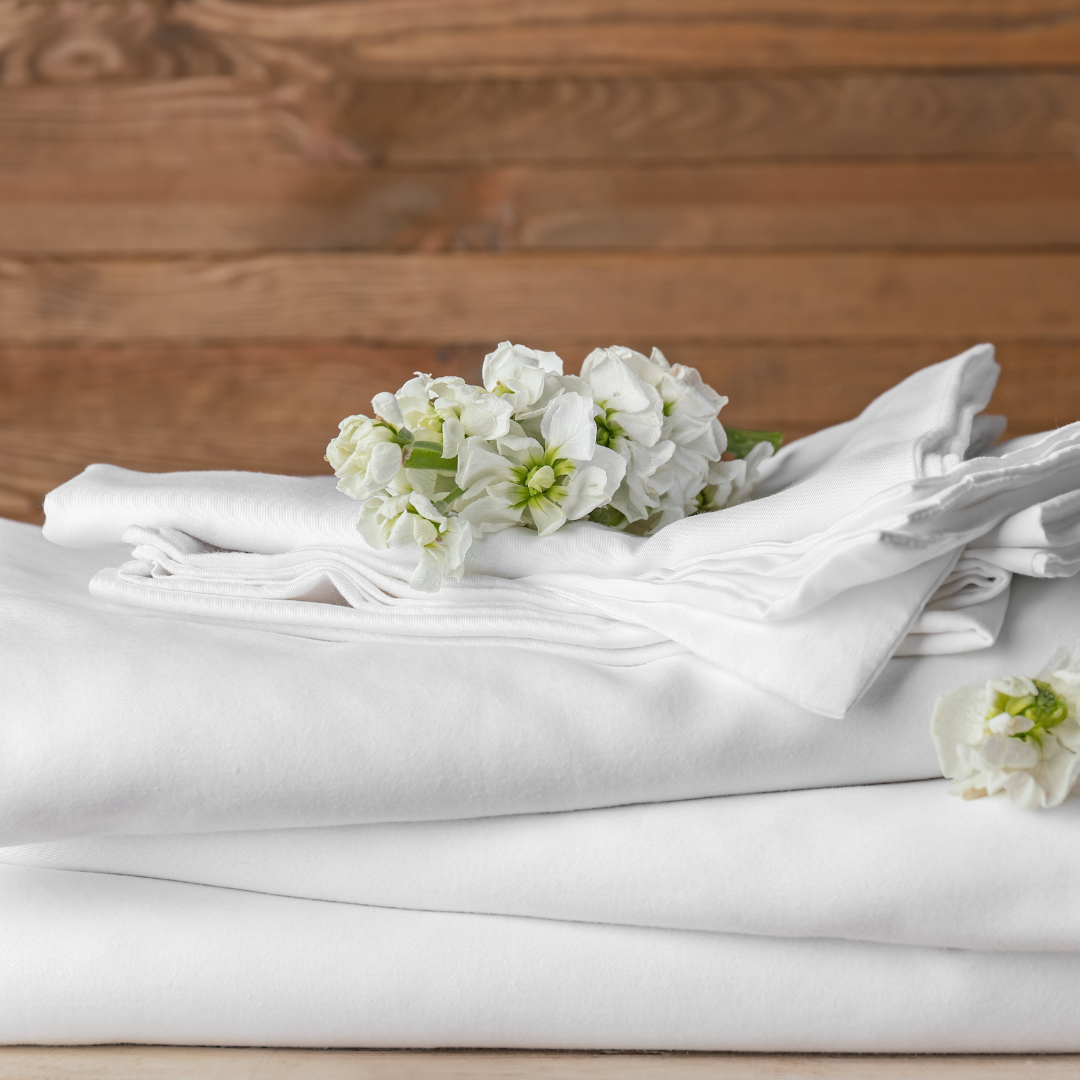Bamboo sheets are all the rage these days. If you’re thinking of buying a set, you might be wondering – do bamboo sheets shrink?
Unfortunately, this is a common problem with bamboo fabric. Read on to learn more about why bamboo shrinks, and what you can do to prevent it!
What is Bamboo Fabric?

Bamboo fabric is a type of textile made from the fibers or fibres of the bamboo plant.
It is known for its softness, breathability, and environmental sustainability.
Bamboo fabric can be produced using different methods, including mechanically crushing the bamboo plant and spinning the fibers into yarn, or chemically processing the plant to extract the cellulose to create a viscose or rayon fabric.
Bamboo fabric is often used to make a variety of products, such as clothing, bedding, towels, and more.
It has gained popularity in recent years due to its natural properties and the increasing interest in eco-friendly alternatives to traditional fabrics.
Bamboo fabric is hypoallergenic, resistant to bacteria and odors, and has excellent moisture-wicking abilities.
This makes it an ideal choice for those with sensitive skin or those seeking a comfortable and sustainable fabric option.
How is Bamboo Fabric made?

Bamboo fabric is made through a detailed production process that involves harvesting the bamboo plant and transforming it into fiber.
- The first step in creating bamboo fabric is the harvesting of bamboo plants, which are known for their quick and sustainable growth.
- Once harvested, the bamboo is processed to extract the fibers. This process typically involves pulping the bamboo, which breaks it down into a mushy substance.
- The bamboo pulp is then spun into fibers, using either a mechanical or chemical process.
- To transform bamboo fibers into fabric, they are often combined with other natural or synthetic materials and then woven into fabric. The weaving process involves interlacing the fibers to create a solid and durable material.
- Chemicals are sometimes used by other bamboo bedding companies in the production process of bamboo fabric. Some manufacturers use a chemical process called hydrolysis alkaline to turn the bamboo pulp into fibers.
- However, there are also eco-friendly methods that use enzymes to break down the pulp and create bamboo fibers which allows for a more natural process, which is used by The Bamboo Bed.
It is important to note that the environmental impact of bamboo fabric production can vary depending on the methods used.
Some production processes require a significant amount of water and chemicals, which can have negative effects on the environment.
However, there are also eco-friendly methods that minimize the use of chemicals and water.
In conclusion, bamboo fabric is made through a multi-step process that involves pulping and spinning the bamboo plant into fibers, as well as weaving those fibers into fabric.
While some production methods may involve the use of chemicals, there are also eco-friendly options available.
Do Bamboo Sheets Shrink?
Many people are drawn to bamboo fabric for its softness, breathability, and eco-friendliness. However, one common concern when it comes to bamboo fabric is whether or not it will shrink.
In this article, we will explore the shrinkage properties of bamboo fabric, providing you with the information you need to properly care for your bamboo garments and ensure their longevity.
Natural Properties of Bamboo Fibers

Bamboo fibers have unique natural properties that make them highly sought-after in the textile industry.
One of the most notable features of bamboo fabric is its exceptional softness.
The smooth and silky texture of bamboo fabric makes it a popular choice for luxurious and comfortable bedding.
In addition to its softness, bamboo fabric is also highly breathable. The porous structure of bamboo fibers allows for better air circulation, ensuring that the fabric stays cool and comfortable even in hot and humid conditions.
This breathability also helps to wick away moisture from the body, making bamboo fabric an excellent choice for sheets and comforters.
Another advantage of bamboo fabric is its hypoallergenic nature. The antimicrobial properties of bamboo fibers naturally repel bacteria and fungus, making it an ideal option for those with sensitive skin or allergies.
Additionally, bamboo fabric provides protection against harmful UV rays, making it a smart choice for blankets for babies to use while outdoors.
Overall, bamboo fabric offers a range of natural properties that contribute to its exceptional comfort and performance.
Its softness, breathability, moisture-wicking capabilities, hypoallergenic nature, and UV protection make it a versatile and increasingly popular choice in the textile industry.
Effects of Heat on Bamboo Fabrics

Bamboo fabric is known for its durability and softness, but it's important to be aware of the effects of heat on this natural material. Let's delve into how heat can impact bamboo fabrics, including the potential for shrinkage.
While bamboo fabric is thermo-regulating, meaning it adjusts to the body temperature and can retain heat, excessive heat in the drying process can lead to shrinkage.
High heat settings in the washing machine or the dryer can cause the fabric to contract, resulting in a smaller size compared to its original dimensions.
To prevent shrinkage, it is recommended to:
- wash bamboo clothing in lukewarm water rather than hot water, and using a gentle cycle is advisable.
- Avoid using excessive heat in the dryer and opt for air drying instead.
- Additionally, using a mild detergent specifically designed for delicate fabrics can help preserve the fabric's integrity.
Proper care instructions, which can often be found on the care label of bamboo garments, should be followed to ensure the longevity and maintain the original size of the fabric.
By taking precautions and avoiding excessive heat, you can enjoy the benefits of bamboo clothing while minimizing the risk of shrinkage.
Effects of Cold on Bamboo Fabrics

Cold temperatures can have a significant impact on bamboo fabrics. While bamboo is known for its natural properties of thermo-regulation, meaning it adjusts to body temperature, it can also be affected by cold weather.
One of the potential effects of cold temperatures on bamboo fabrics is that they may become stiffer and less flexible.
This can result in a loss of the fabric's characteristic softness and draping quality. Additionally, bamboo fabrics may feel cooler to the touch in cold weather, as they do not retain heat as effectively as in warmer conditions.
Maintaining the quality of bamboo fabrics in cold conditions can pose some challenges.
The fabric may be more prone to wrinkling and creasing, requiring more careful handling and ironing.
It is important to avoid exposing bamboo fabrics to excessive moisture or dampness in cold weather, as this can lead to the growth of mold or mildew.
To mitigate the impact of cold temperatures on bamboo fabrics, it is advisable to store them in a dry and well-ventilated area. Additionally, using a fabric softener specifically designed for bamboo fibers can help maintain their softness and flexibility.
Despite the potential challenges, bamboo fabrics can still provide comfort and breathability in cold weather. Their natural properties make them a versatile choice for various types of home textiles.
Care Instructions and Labels

Care instructions and labels are of utmost importance when it comes to washing bamboo fabric. They provide vital information on the proper washing and drying techniques to ensure the longevity and quality of your bamboo bedding.
Before washing your bamboo fabric, it is essential to read and understand the care tag. This small label contains valuable instructions on the appropriate water temperature, washing cycle, and recommended detergents to use.
Following these guidelines will help prevent any potential damage or shrinkage to your bamboo bedding.
Not adhering to the care instructions can result in risks such as weakening or tearing of the fabric. Using harsh detergents or high heat settings on the washing machine or dryer can be detrimental to the integrity of the bamboo fibers, causing them to break down over time. Additionally, using excessive force during washing or drying can lead to pilling or fraying of the fabric.
To ensure your bamboo bedding stays in optimal condition, it is essential to properly follow the care instructions and labels. By doing so, you can enjoy the benefits of soft, luxurious bamboo fabric while avoiding any potential risks that may compromise its durability and quality.
Washing Machine Settings

When it comes to washing bamboo fabric, it's important to choose the right settings on your washing machine to ensure the fabric's longevity and minimize shrinkage.
The recommended setting for washing bamboo fabric is the delicate or gentle cycle.
This is because these settings provide a more gentle and slower agitation, which helps to preserve the integrity of the fabric.
In terms of water temperature, it is best to use cold water when washing bamboo fabric.
Cold water helps to prevent excessive moisture absorption and shrinkage. The cool temperature also helps to maintain the fabric's moisture-wicking ability, keeping you comfortable and dry throughout the night.
If possible, it is recommended to hand wash bamboo fabric for ultimate care and protection. However, if you prefer to use a washing machine, be sure to select the delicate setting and cold water to minimize any potential damage to the fabric.
Additionally, avoid using harsh detergents or bleach, as these can be damaging to the natural fibers of bamboo fabric.
By following these washing machine settings - using the delicate cycle and cold water - you can help preserve the softness, quality, and size of your bamboo fabric for years to come.
Drying Processes and Heat Setting

Properly drying bamboo fabric is crucial to prevent shrinkage and maintain its quality. There are various drying processes for bamboo fabric, each requiring different heat settings to ensure the fabric's integrity.
Air drying is the preferred method as it reduces the risk of shrinkage and damage.
After washing, gently squeeze out excess water and lay the bamboo fabric flat on a clean, dry surface. Avoid direct sunlight to prevent fading and maintain the fabric's original size.
If using a dryer, it is important to select low heat settings to prevent shrinkage. Set the temperature to a gentle or delicate cycle, using the lowest heat option available. Avoid using high heat, as it can cause the bamboo fabric to shrink and lose its softness.
When using a dryer, bamboo fabric can also be hung to dry. Hang it on a drying rack or clothesline, allowing it to air dry naturally. This method avoids excessive heat exposure and helps maintain the fabric's original shape and size.
To further protect the bamboo fabric, avoid overcrowding the dryer or hanging multiple pieces together.
This prevents excessive moisture buildup and reduces the risk of shrinkage.
By following these drying processes and appropriate heat settings, you can effectively prevent bamboo fabric from shrinking and maintain its quality for a longer period.
Other Factors That Affect Shrinking

In addition to cold temperatures, there are several other factors that can affect the shrinking of bamboo fabric. One of these factors is excessive washing and drying.
The repeated exposure to water and heat can cause the bamboo fibers to weaken, making the fabric more prone to shrinking.
Improper water usage is another factor that can contribute to the shrinking of bamboo fabric.
Using hot water instead of the recommended cold or lukewarm water can cause the fibers to shrink and lose their original size. Similarly, using high heat settings on the washing machine or dryer can accelerate the shrinkage process.
Detergent build-up is also a common culprit behind the shrinking of bamboo fabric.
When detergent residue accumulates on the fibers, it can create a barrier that restricts their natural flexibility.
This can result in the fabric shrinking when exposed to water or heat.
Furthermore, bamboo fabric has a high water absorption rate, which means it absorbs moisture more readily than other types of fabrics.
Excessive moisture, whether from improper washing or excessive perspiration, can cause the fibers to expand and contract, leading to shrinkage over time.
To minimize the shrinking of bamboo fabric, it is important to follow the care instructions provided on the garment's label.
This may include recommendations for using mild detergents, washing with cold or lukewarm water, and air drying instead of machine drying.
By avoiding excessive washing and drying, improper water usage, detergent build-up, and high water absorption, you can help preserve the quality and size of your bamboo fabric garments.
How To Prevent Bamboo Sheets from Shrinking
The bamboo fabric easily shrinks if you’re not careful. Some report that their bamboo fabrics shrink by up to 6 percent.
Here are some tips for caring for your bamboo sheets to prevent them from changing in size:
1. Machine Wash Cold
When washing your bamboo bed sheets, follow the manufacturer’s instructions for what temperature you should clean them. Generally, 30 degrees or less is the ideal temperature for washing these sheets.
2. Avoid Bleach and Fabric Softeners
Bamboo sheets are already ultra-soft and don’t need any chemical help! Bleaches and fabric softeners can damage fiber integrity and cause fabric shrinkage and other distortions.
3. Gentle Wash
Be sure to wash your sheets on the gentle cycle after washing. Gentle cycles help the bamboo sheets retain their natural soothing properties. All-natural fabrics benefit from a gentle cycle as a heavier wash cycle compromises the moisture-wicking ability, softness, and the sheet’s overall size.
4. Do Not Tumble Dry at High Temperature
Generally, it is best to air dry your sheets. This gives you the best chance of preserving the fibers, texture, and colors of the sheets. If you need to dry them, make sure you use an airing or low heat setting and a low heat drying cycle. Once the sheets are cycle dried, remove them immediately to prevent further shrinkage. The sheets can not only shrink at high temperatures but also have a higher risk of tearing.
5. Wash Your Bamboo Sheets Separately
Not all fabrics are the same. Your bamboo sheets and sheets in general should always be washed separately from other clothes and garments. Washing bamboo sheets with other everyday items causes chafing and compromises sheet integrity and durability.
6. Store Your Sheets Properly
Sheet storage is often not the first thing that springs to mind when trying to find the answer to the question, “Do bamboo sheets shrink?” However, when it comes to storage, you should protect your sheets from direct sunlight and damp places to avoid damaging the soft fibers that can cause the bamboo sheets to shrink. As a natural fiber, bamboo is much more vulnerable to the effects of moisture and heat than synthetic fibers.
Care for Bamboo Sheets During Subsequent Washes
Use lukewarm water at 40 degrees Celsius (104 degrees Fahrenheit) to wash the bamboo sheets. You should not use hot water as it can damage your bamboo sheets.
The high temperature from hot water and the dryer sucks the moisture out of the bamboo bedding and damages the viscose in the bamboo fibers.
This reduces the longevity of even your bamboo sheet sets as the bamboo fabric is considered delicate. Therefore, be very careful when washing and drying your bamboo sheets.
You should also wash the bamboo sheets on a gentle cycle. Too much friction from the washing machine can also damage the fibers.
Although the sheets are stiff when you take them out of the washing machine, they become extremely soft once they are completely dry.
Therefore, avoid using fabric softeners and dryer sheets on your bamboo bedding.
Different Types of Shrinkage
There are several types of shrinkage. The first type is known as felting shrinkage. This type of shrinkage occurs in garments made from animal fibers. Felting shrinkage is often known as progressive shrinkage because it occurs more and more each time the fibers are washed. This type of shrinkage does not affect the best bamboo bed sheet sets.
Relaxation shrinkage occurs when fabrics such as cotton, linen, silk, or high-performance synthetic fibers are exposed to excessive moisture. When the fibers are exposed to water, they absorb it and expand.
This causes the fabric to shrink. The shrinkage only occupies 1% of the entire piece and won’t do much damage. Relaxation shrinkage doesn’t seriously affect bamboo sheets.
Consolidation shrinkage is the type that is applied to bamboo sheets. Bamboo sheets shrink because of a combination of heat, excess moisture, and mechanical impact.
These factors combine to cause the bamboo fibers to release any stress or strain that may have been placed on the fabric during the production of the sheets.
When this happens, the fibers retract completely, causing shrinkage. This type of shrinkage is usually more noticeable in the first wash, so sheets are usually slightly larger to accommodate this.
Do Bamboo Sheets Shrink in The Dryer?
As mentioned, it’s best not to put them in the dryer after washing to keep them silky smooth.
The dryer is more likely to shrink the sheets because of the heat it generates. Not only that, but the dryer is likely to leave your sheets wrinkled when it’s done.
Air-dried sheets have an incomparable freshness, and when dried in a cool breeze, they are wonderfully fragrant.
Final Thoughts
So, do bamboo sheets shrink? While some shrinkage is unavoidable on your bamboo sheets; there are several steps you can take to ensure your soft and inviting bamboo sheets stay that way.
All Bamboo Bed’s bamboo products come with detailed care instructions you must follow to extend the life of your sheets. If you want your bamboo fitted sheet to be a little firmer, you can dry it in the dryer while you line-dry the other sheets.
Check out our full range of products today and get ready for a good night's sleep!









